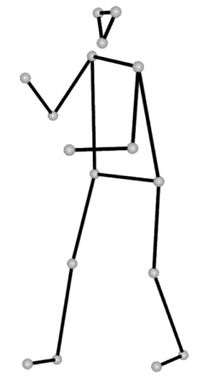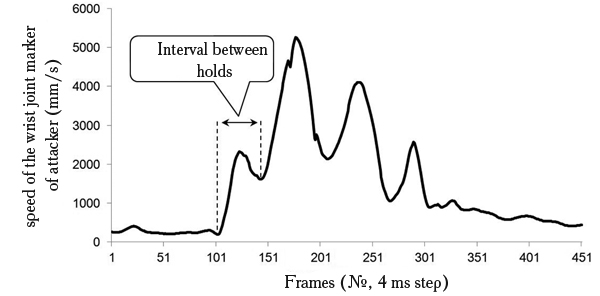Attacking Wrestler's Agility as a Factor Influencing Opponent's Response Time
Фотографии:
ˑ:
A.A. Shipilov, junior researcher
Research institute of sport of Russian state university of physical culture, sport, youth and tourism (SCOLIPC), Moscow
Key words: wrestling, combined actions, response time, psychological refractoriness.
Introduction. The primary components of wrestler's tactical skills are the skill to use favourable conditions to perform technical actions, arising during a bout and the skill to create them independently using various tactical methods. A technical action performed during competitive practice and prior tactical training form so called combinations (or combined actions). A.N. Lenz characterizes this concept in the following way: “Combination is a tactically appropriate combination of two or more attack (counterattack) actions when the opponent's defense reaction in response to the previous action is used in the next action”. “Any combination is made of preparatory and finishing actions. The preparatory action creates favourable conditions to perform the finishing one” [8]. According to educational observations, wrestler's actions arranged this way are more efficient compared to single holds.
To successfully complete a combination a wrestler needs to observe a time interval between the preparatory and finishing holds. First it was confirmed experimentally by A.P. Kuptsov. In his thesis, he showed that an attacker (tori), acting with the proper speed, can effectively use the state of reduced stability of the posture of a defending wrestler (uke), that occurs and persists for a short time after a preparatory hold. Hereat, the duration of the interval between holds of the combination should be less than the time of response of the defender to the preparatory hold [5, 6, 7].
According to the works in the field of experimental psychology, the defender’s agility when executing combined actions can be a factor influencing the opponent's response time. In the 30-s of the last century C.W. Telford found, that there is a delay in the response to the second of two stimuli following one another at a short time interval. This phenomenon was called "psychological refractoriness" [16]. Subsequently, it was determined experimentally that the greatest response delays occur at the shortest time intervals between the presented stimuli, i.e. when the occurrence of the second stimulus falls on the latent period or the beginning of the motor component of the first reaction, and delays decrease with increasing interstimulus interval [2, 3, 4, 9, 10, 11, 12, 14, 15, 17].
Table 1 presents the findings of R. Davis [11]. In his study, he used a task with two visual stimuli, that were consistently applied to the subject with different time intervals. The subject responded to stimuli by pressing a button. The time difference between the second and the first reactions is the duration of the delay.
Table 1. The findings of R. Davis. Response time of the subject to consistently applied stimuli
|
Interval between stimuli (ms) |
Response time to the 1st stimulus (ms) |
Response time to the 2nd stimulus (ms) |
||
|
|
σ |
|
σ |
|
|
50 |
159 |
14 |
286 |
27 |
|
100 |
153 |
15 |
224 |
34 |
|
150 |
162 |
16 |
204 |
21 |
|
200 |
168 |
26 |
185 |
26 |
|
250 |
164 |
24 |
172 |
25 |
|
300 |
157 |
17 |
166 |
15 |
The response delay increases when motor or perceptual tasks get more complex [4]. For example, the experimental conditions of N.D. Gordeeva presupposed responding to visual stimuli not simply by pushing the button (as in R. Davis), but moving a controlled cursor on the screen to certain goals. According to the results of these experiments, the average reaction delay of a subject at interstimulus intervals of 50, 100, 150 ms was 150, 120, 100 ms respectively. Complicating the task by increasing the number of possible answers to both the first and the second stimuli (i.e., actually a transition from simple to complex reaction) increases response delays too [13].
Thus, according to the findings of psychological researches, a significant increase in the time of the second reaction relative to the time of the first reaction is observed in the subjects in the simplest tasks with the "double" stimuli.
By analogy with laboratory experiments, an attacked wrestler may have a delay of response to the finishing hold of the combination, provided that the interval between holds will be less than the time of his reaction to a preparatory hold.
The purpose of the research was to study the time characteristics of combined actions of attacking wrestler, as a factor influencing the opponent's response time.
The main task of the experimental part of the study is measuring the time interval between preparatory and finishing holds in combined actions of elite wrestlers.
Materials and methods. The three-dimensional kinematic analysis implemented using the optoelectronic system Qualisys was chosen as the main research method.
24 athletes aged 20 to 26 years, ranked candidate masters and masters of sports in Greco-Roman (n = 14) and freestyle wrestling (n = 10), participated in the experiment.
The subject was to perform the combination: neck and arm snatch - passage to the body (body and single arm hold). This combination is easy to do and is used in both freestyle and Greco-Roman wrestling, therefore, it was selected as a motor task in our study. The wrestler with similar anthropometric data performed the role of defender (Tab. 2)
Table 2. Anthropometric data of subjects
|
|
Group 1 (weight category below 84 kg), n=12 |
Group 2 (weight category below 74 kg), n=12 |
|
Height (cm) |
179,3±5,5 |
171±5,6 |
|
Weight (kg) |
86,1±3,4 |
75,8±0,6 |
After explaining the task, markers-reflectors were attached to the subjects along the axes of the following joints: shoulder, elbow, wrist, hip, knee, ankle, first metatarsophalangeal. Moreover, markers were fixed on the head: left temple, right temple and chin. Put together, the markers form a multilink model of the body (Fig. 1), which provides the detailed information about the subject’s actions.

Fig. 1. Multilink model of subject’s body.
Then three attempts were recorded, one of which - with the smallest time interval between holds, was taken into account.
The transition from the preparatory hold to the finishing one in the combination is often accompanied by a change of hold and direction of actions of tori (attacker) towards uke (defender). In the chosen combination tori relieves neck grip after a spurt and proceeds to body and single arm hold. Therefore, the moments of the beginning of the preparatory and finishing holds were determined according to the chart of the marker speed on the wrist joint of the right hand of tori, which he uses to perform the neck grip and then the body and single arm hold (Fig. 2). The findings of the study are presented in Table 3.

Fig. 2. Chart of speed of the wrist joint marker of attacking wrestler. Starting a preparatory hold and transition to the finishing one is accompanied by sharp changes in the marker’s speed.
Table 3. The findings of the study: time intervals between holds of the combination shown by subjects
|
Sub. (№) |
Interval (ms) |
Sub. (№) |
Interval (ms) |
Sub. (№) |
Interval (ms) |
Sub. (№) |
Interval (ms) |
|
1 |
196 |
7 |
144 |
13 |
168 |
19 |
160 |
|
2 |
184 |
8 |
128 |
14 |
136 |
20 |
164 |
|
3 |
140 |
9 |
188 |
15 |
208 |
21 |
156 |
|
4 |
180 |
10 |
192 |
16 |
140 |
22 |
200 |
|
5 |
192 |
11 |
172 |
17 |
120 |
23 |
172 |
|
6 |
176 |
12 |
156 |
18 |
124 |
24 |
128 |
The minimum interval in an experiment was 120 ms, the maximum 208 ms. The average value of the interval for all subjects () was 163,5 ± 26,3 ms.
The person's ability to successfully respond to series of signals coming from the environment is limited by the minimum time of his reaction. If two signals come one by one with the interval less than the time of his response, the answer to the second signal is delayed - a response delay (psychological refractoriness) occurs [10].
It is known that the average latency time of the person’s simple response to visual and tactile stimuli (in wrestling visual and tactile perception of opponent is dominating) ranges within 150 to 224 ms and 117 to 201 ms, respectively [1]. Consequently, the average interval between holds demonstrated by subjects - 163,5 ± 26,3 ms - indicates that the finishing hold can be localized either in the latent period, or at the beginning of the motor component of defender’s reaction to the preparatory hold.
Conclusion. Proceeding from the experiment, attacker’s agility during the combination can exceed the psychomotor abilities of defender, provoking the delayed response to a finishing hold. In its turn, the attacking wrestler can use opponent's limited psychomotor abilities to get an advantage in time and finish a combination efficiently.
The adduced information gives a fresh idea of the mechanism of efficiency of combined actions in wrestling in general and indicates the vital role of the interval between holds when performing them.
References
- Boyko, E.I. Human reaction time / E.I. Boyko. – Moscow: Meditsina, 1964. 439 P. (In Russian)
- Gordeeva, N.D. The dynamics of psychological refractoriness in a motor act / N.D. Gordeeva // Voprosy psikhologii. – 1981. – № 2. – P. 79-89. (In Russian)
- Gordeeva, N.D. Microdynamics of the underlying form of action / N.D. Gordeeva // Voprosy psikhologii. – 2000. – № 6. – P. 100. (In Russian)
- Gordeeva, N.D. Experimental psychology of the enforcement process / N.D. Gordeeva. – Moscow: Trivola, 1995. – 324 P. (In Russian)
- Kuptsov, A.P. The dynamics of stability of wrestler’s posture (on efficiency of comprehensive technical and tactical actions in wrestling): Ph.D. thesis / A.P. Kuptsov. – Moscow, 1969. – 288 P. (In Russian)
- Kuptsov, A.P. Modeling attacker’s actions when implementing comprehensive technical and tactical actions / A.P. Kuptsov // Teoriya i praktika fizicheskoy kultury. – 1969. – № 5. – P. 13-16. (In Russian)
- Kuptsov, A.P. On pose stability / A.P. Kuptsov, V.B. Korenberg // Teoriya i praktika fizicheskoy kultury. – 1967. – № 12. – P. 14-18. (In Russian)
- Lenz, A.N. Wrestling / A.N. Lenz. – Moscow: Fizkultura i sport, 1964. – 494 P. (In Russian)
- Davis, R. The human operator as a single channel information system // Quarterly Journal of Experimental Psychology. 1957. V. 9(3). P. 119-129.
- Davis, R. The limits of the «psychological refractory period» // Quarterly Journal of Experimental Psychology. 1956. V. 8(1). P. 24-38.
- Davis, R. The role of «attention» in the psychological refractory period // Quarterly Journal of Experimental Psychology. 1959. V. 11(4). P. 211-220.
- Johnston James, C., McCann Robert, S. On the locus of dual-task interference: Is there a bottleneck at the stimulus classification stage? // The Quarterly Journal of Experimental Psychology. 2006. V. 59(4). P. 694-719.
- Karlin, L., Kestenbaum, R. Effects of number of alternatives on the psychological refractory period // Quarterly journal of experimental psychology. 1969. V. 20(2). P. 167-178.
- McLeod, P. Parallel processing and the psychological refractory period // Acta Psychologica. 1977. V. 41. P. 381-396.
- Sigman, M., Dehaene, S. Parsing a Cognitive Task: A Characterization of the Mind’s Bottleneck // PLoS Biology. 2005. V. 3(2). P. 334-349.
- Telford, C.W. The refractory phase of voluntary and associative responses // Journal of Experimental Psychology. 1931. V. 14(1). P. 1-36.
- Welford, A.T. Evidence of a single-channel decision mechanism limiting performance in a serial reaction task // Quarterly Journal of Experimental Psychology. 1959. V. 11(4). P. 193-210.
Author’s contacts: Tabularasa86@yandex.ru




